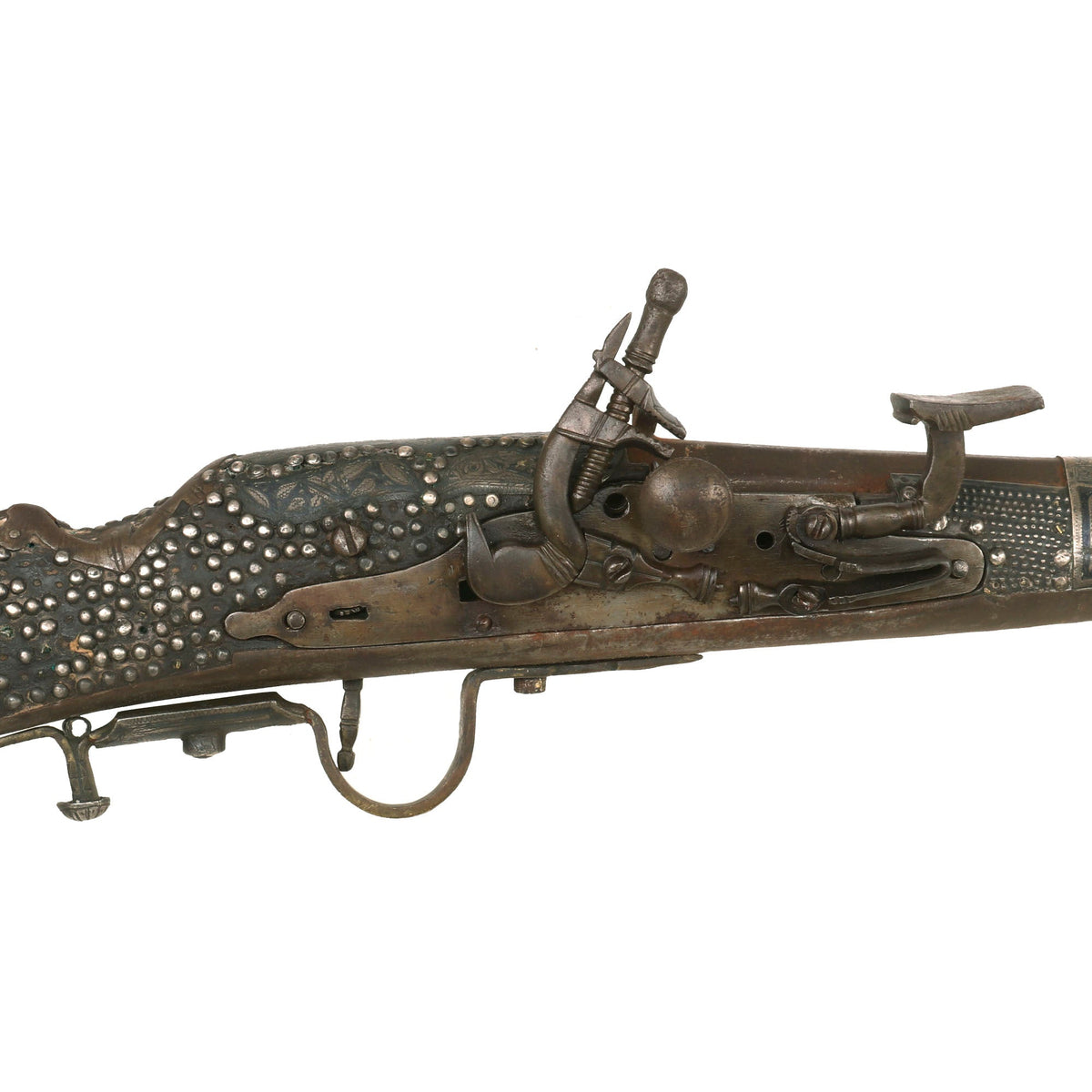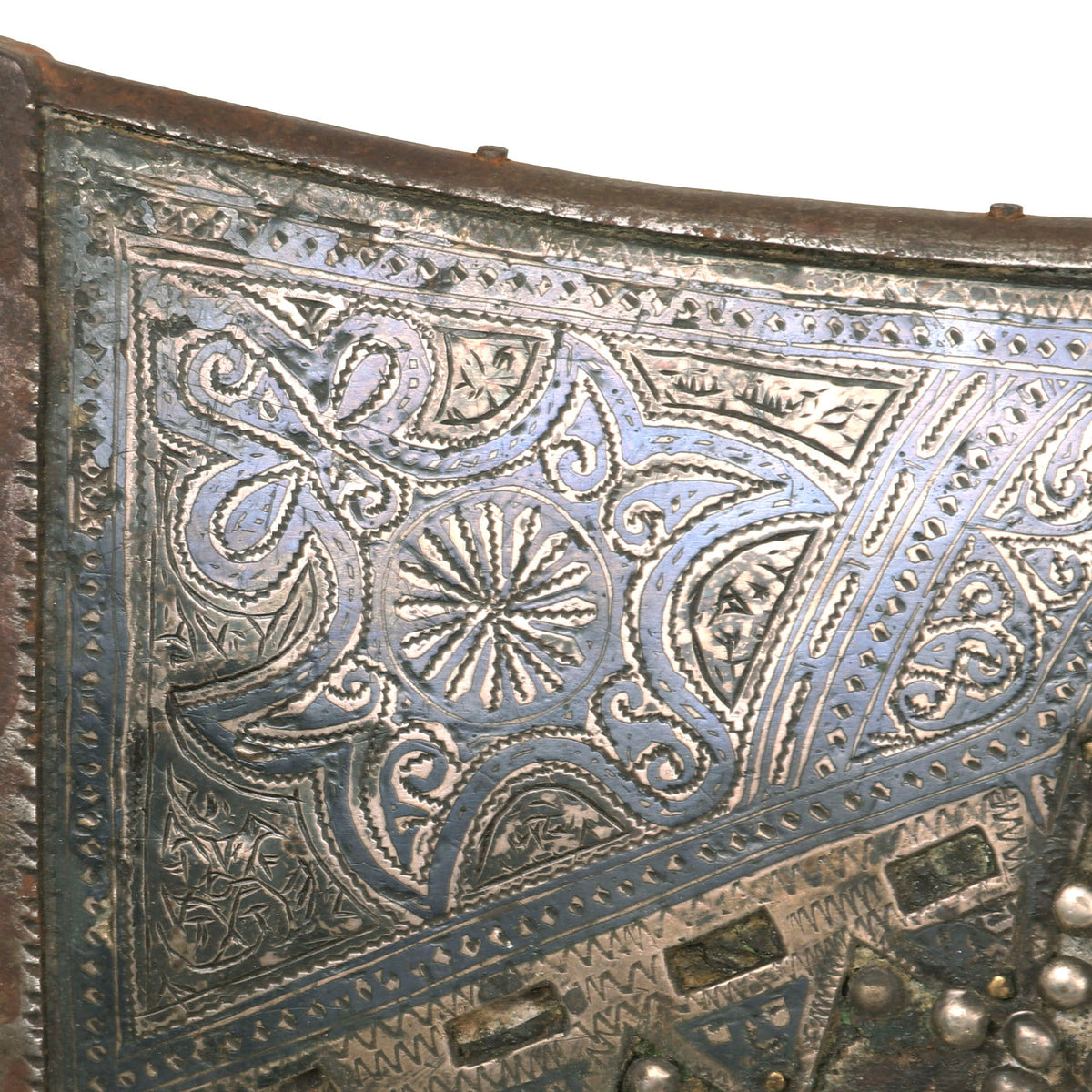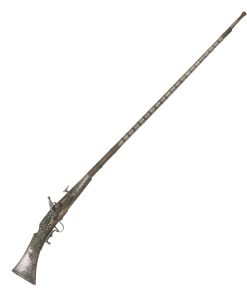Original Early 19th Century North African Kabylia Style Snaphaunce Lock Jezail with Niello & Silver Ornamented Stock Original Items
$ 1.295,00 $ 323,75
Original Item: One of a Kind. The Jezail (sometimes Jezzail from the Arabic) is a simple, cost-efficient and typically handmade muzzle-loading long arm commonly used in the Middle East region in the past. These were all highly personalized, so no two were alike. They were often made with locally available locks, so it was common to see locks on these that were of varied origin. This example is all locally made, and probably originates from the North African region, anywhere from Morocco in the West to Saudi Arabia in the East. It features a somewhat primitive but attractive snaphaunce style lock.
King Philip III of Spain signed an EDICT OF EXPULSION in 1609 to purge the nation of over half a million “Moors” who had arrived in Spain over the previous 500 years. These unfortunates were compelled to return to their ancestor’s lands in North Africa. When leaving they took many “Western Skills” learned in Spain with them. Gunmaking was one such skill and a contingent of Muslim Gunsmiths set up in the City of Tetuan in what we now call Morocco.
They continued to make the latest style of firearms then dominant in Spain which was the SNAPHAUNCE system, a forerunner of the traditional FLINTLOCK soon to be introduced in France. These Arab made long guns intended for use from the saddle of a Camel were smooth bored but surprisingly accurate and production of the same ignition system continued for over 200 years and more even through the late Victorian era.
This example is definitely NOT suitable for shooting anymore, only for display. Probably around 200 years old, this flintlock action Jezail musket was exactly what the North African Arabs used while riding a Camel. Remember the Movie “BEAU GESTE”? Modeled after those Spanish 17th Century examples, these were made up until almost the end of the Victorian era and most of those encountered returned with Colonial Soldiers returning from overseas assignments.
This gorgeous example has an octagonal barrel 51 ½ inches in length, with a small bore around .50 caliber at the muzzle, but the muzzle is swamped, so we estimate it to be roughly .35 caliber. There are a few tiny holes in the barrel at the muzzle. It measures an impressive 65 inches in overall length. The jezail looks to have seen long service, showing damage in several places. The stock, primarily the buttstock, is heavily encrusted with silver nails. This both helped to decorate as well as to stabilize the cracked wood, very common on these extremely thin stocks. There was a ram rod in the rifle at one point, but it is gone.
The fore stock shows much of the original wood, with some 21 soldered on sheet iron barrel bands, while the rear shows less due to the brass covering. Still, most of the wood is visible, showing carved designs, and there are numerous silver tacks laid out in a decorative pattern. This would also serve to make the checkered wrist area easier to grip. It does not appear to have ever had sling swivels, but the back of the trigger guard has a precious jewel embedded with Niello ornamentation around it and the rest of the trigger guard. he back of the buttstock is also gorgeously decorated with Niello on both sides, resulting in a truly stunning design.
Niello is a black mixture, usually of sulfur, copper, silver, and lead, used as an inlay on engraved or etched metal, especially silver. It is added as a powder or paste, then fired until it melts or at least softens, and flows or is pushed into the engraved lines in the metal. It hardens and blackens when cool, and the niello on the flat surface is polished off to show the filled lines in black, contrasting with the polished metal around it. It may also be used with other metalworking techniques to cover larger areas, as seen in the sky in the diptych illustrated here. The metal where niello is to be placed is often roughened to provide a key.
The lock almost looks to be European in manufacture, and very well may have been originally, later decorated in North Africa. It is not functional, not holding at either half or full cock, although it is very beautifully designed. There are proof marks along the barrel, although they were often just copied from European guns and are likely meaningless. The long barrel band in front of the action is also gorgeously ornamented with Niello, as is the stock opposite the lock. This is truly one of the most gorgeous Jezails we have offered.
Truly attractive with understated elegance! Fully cleaned and looking its best, ready to display!
Specifications:
Years of Manufacture: Circa 1800
Caliber: approx .35 inches
Ammunition Type: Lead Ball & Powder
Barrel Length: 51½ inches
Overall Length: 65 inches
Action: Snaphaunce Lock
Feed System: Muzzle-Loaded
History of the Snaphaunce Lock:
A snaphance or snaphaunce is a type of lock for firing a gun or is a gun using that mechanism. The name is Dutch in origin but the mechanism can not be attributed to the Netherlands with certainty. It is the mechanical progression of the wheellock firing mechanism, and along with the miquelet lock and doglock are predecessors of the flintlock mechanism. It fires from a flint struck against a striker plate above a steel pan to ignite the priming powder which fires the gun. Examples of this firearm can be found through Europe, North Africa, and the Middle East.
NOTE: International orders of antique firearms MUST be shipped using UPS WW Services (courier). USPS Priority Mail international will not accept these. International customers should always consult their country’s antique gun laws prior to ordering.
Fast Shipping with Professional Packaging
Thanks to our longstanding association with UPS FedEx DHL, and other major international carriers, we are able to provide a range of shipping options. Our warehouse staff is expertly trained and will wrap your products according to our exact and precise specifications. Prior to shipping, your goods will be thoroughly examined and securely secured. We ship to thousands clients each day across multiple countries. This shows how we're dedicated to be the largest retailer on the internet. Warehouses and distribution centres can be located throughout Europe as well as the USA.
Note: Orders with more than one item will be assigned a processing date depending on the item.
Before shipping before shipping, we'll conduct a thorough inspection of the items you have ordered. Today, the majority of orders will be delivered within 48 hours. The delivery time will be between 3-7 days.
Returns
The stock is dynamic and we cannot completely manage it because multiple stakeholders are involved, including our factory and warehouse. So the actual stock may alter at any time. It's possible that you may not receive your order once the order has been made.
Our policy is valid for a period of 30 days. If you don't receive the product within 30 days, we are not able to issue a refund or an exchange.
You can only return an item if it is unused and in the same state as the day you received it. You must have the item in its original packaging.
Related products
Uncategorized
Uncategorized
Uncategorized
Uncategorized
Uncategorized
Uncategorized
Uncategorized
Uncategorized
Armored Burgonet Helmet & Polearm from Scottish Castle Leith Hall Circa 1700 Original Items
Uncategorized
Uncategorized
Uncategorized
Uncategorized
Australian WWII Owen MK1 Machine Carbine SMG Custom Fabricated Replica with Sling Original Items
Uncategorized
Uncategorized
Uncategorized
Uncategorized
Uncategorized
Angolan Rebel 1970s era 60mm Inert Display Mortar from Angolan Civil War Original Items
Uncategorized
Uncategorized
Uncategorized
Uncategorized













































































